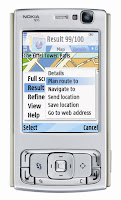In Seven Years...

Step back to the future. Tell me what you don't see as you watch this clip from the original Star Trek. ( Please ignore the sponsor commercial a the beginning of the clip. I couldn't make it go away. Just click on the photo.)
After you watch the Star Trek clip, think about what is there but never mentioned or acknowledged.
In developing the series in the mid-1960's Gene Roddenberry invited leading scientists and researchers to review the technology. In addition to possibilities, Roddenberry asked these scientists to answer one additional question. "What technology, what advances would people in the future notice?"
The story goes that the consensus, which proved Roddenberry's point, was that people don't pay attention to technology. They use it and expect it to respond.
In fact, humans become overwhelmed with too much technology. Just take a look at what happens when technology takes center stage. (Again, ignore the sponsor's plug I can't seem to get it to go away.)
An interesting aside, both Get Smart and Star Trek were made during the same era. Wireless communication for the masses didn't exist. Telephones were hard-wired into walls. Infrared motion detectors that allow doors to slide open as you approach didn't exist. computers filled stories of buildings. No PCs. No Macs. No Microwaves. Yet the creators of both shows envisioned the possibilities.
And that is exactly what we have been asked to do in JOMC 712--envision a world that yet does not exist.
So where do we begin to dream? Nathan.com echos the premise of Star Trek's creator and the scientists who help craft his vision of the future. Technology changes, but people do not.
In 100 years, no one will remember memory sticks, or CDs or iPods.
In 100 years, people will laugh, love, struggle and dream.
This thread of life, if you will, crosses the centuries. These sentiments have been expressed through every generation, in every culture, in every language. The technology we use only connects us to one another. It is only when we are isolated that we search for better ways to connect. So, where will technology place us in seven years? What will survive?
 Y2k
Y2k
Seven years ago, the ultimate technology in cellular phones was this Nokia. Sleek. Simple. Users could play a few games. Using a computer connection or perhaps one of the rare wireless 'hubs', users could also download a ring tone and a new game. The phone contained a simple calendar, memo and contact functions.
And the promise of a world to to come suggests
you will always be able to stay in touch.
 So, how far in the future can tricorders, communicators, phasers and computers that rely solely upon voice command be ?
So, how far in the future can tricorders, communicators, phasers and computers that rely solely upon voice command be ?Rather than searching for words in a narrow box, the Web will eventually evolve into a "thinking" resource with the technology to support abstract questions. That work is already underway. At CalTech, at MIT, and other prestigious schools researchers are creating a "thinking" Web. Perhaps in the next decade, we will be closer to the dream that was Star Trek. Perhaps it will be a time when all you do is touch a screen, voice a command and ask a question.
 Go Where No Man Has Gone Before...but Goes Forever
Go Where No Man Has Gone Before...but Goes ForeverWhere will we be in seven years. Technology and research indicate that we will be able to call up a video, share it around the world and using technology like Twttr, provide the world with a moment by moment snippet of our lives. Video journalists will carry iPhones with video capabilities and decent audio. CDs will be on the wane and HDTV will have a questionable future. You'll be able to access the Web easily from your phone, your television set or your iPod.
But people will live, love, laugh, cry and mindlessly use technology, just the same way they did--and will do in the 23rd century. Technology will continue to help us, to confound us, and amaze us.
As for that Star Trek episode, the things that no one paid attention to included elevators that travel in all directions, large screen viewers, instant, clear communications to a planet far away. Still the most important elements on the screen were the relationships.





































